
Carmilla is an 1872 Gothic novella by Irish author Sheridan Le Fanu and one of the early works of vampire fiction, predating Bram Stoker's Dracula (1897) by 25 years. First published as a serial in The Dark Blue (1871–72), the story is narrated by a young woman preyed upon by a female vampire named Carmilla, later revealed to be Mircalla, Countess Karnstein. The character is a prototypical example of the lesbian vampire, expressing romantic desires toward the protagonist. The story is often anthologised, and has been adapted many times in film and other media.
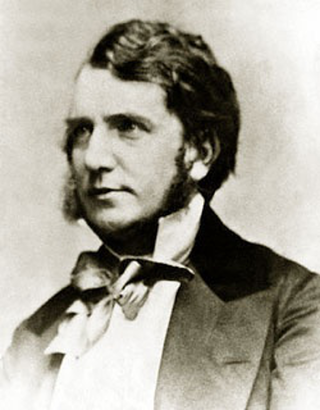
Joseph Thomas Sheridan Le Fanu was an Irish writer of Gothic tales, mystery novels, and horror fiction. He was a leading ghost story writer of his time, central to the development of the genre in the Victorian era. M. R. James described Le Fanu as "absolutely in the first rank as a writer of ghost stories". Three of his best-known works are the locked-room mystery Uncle Silas, the lesbian vampire novella Carmilla, and the historical novel The House by the Churchyard.

Ingrid Pitt was a Polish-British actress and writer, best known for her work in horror films of the 1970s.

Dracula's Daughter is a 1936 American vampire horror film produced by Universal Pictures as a sequel to the 1931 film Dracula. Directed by Lambert Hillyer from a screenplay by Garrett Fort, the film stars Otto Kruger, Gloria Holden in the title role, and Marguerite Churchill, and features, as the only cast member to return from the original, Edward Van Sloan – although his character's name was altered from "Van Helsing" to "Von Helsing".

Vampire films have been a staple in world cinema since the era of silent films, so much so that the depiction of vampires in popular culture is strongly based upon their depiction in films throughout the years. The most popular cinematic adaptation of vampire fiction has been from Bram Stoker's 1897 novel Dracula, with over 170 versions to date. Running a distant second are adaptations of the 1872 novel Carmilla by Sheridan Le Fanu. By 2005, the Dracula character had been the subject of more films than any other fictional character except Sherlock Holmes.
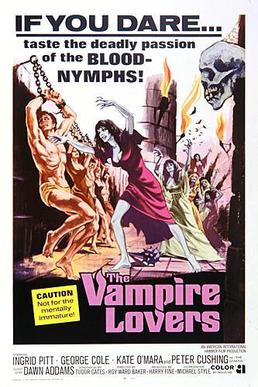
The Vampire Lovers is a 1970 British Gothic horror film directed by Roy Ward Baker and starring Ingrid Pitt, Peter Cushing, George Cole, Kate O'Mara, Madeline Smith, Dawn Addams, Douglas Wilmer and Jon Finch. It was produced by Hammer Film Productions. It is based on the 1872 Sheridan Le Fanu novella Carmilla and is the first film in the Karnstein Trilogy, the other two films being Lust for a Vampire (1971) and Twins of Evil (1971). The three films were somewhat daring for the time in explicitly depicting lesbian themes.

Erotic horror, alternately called horror erotica or dark erotica, is a term applied to works of fiction in which sensual or sexual imagery are blended with horrific overtones or story elements for the sake of sexual titillation. Horror fiction of this type is most common in literature and film. Erotic horror films are a cornerstone of Spanish and French horror.
The Karnstein Trilogy is a series of vampire films produced by Hammer Films. They are notable at the time for their daring lesbian storylines. All three films were scripted by Tudor Gates. They are related by vampires of the noble Karnstein family, and their seat Castle Karnstein near the town of Karnstein in Styria, Austria.
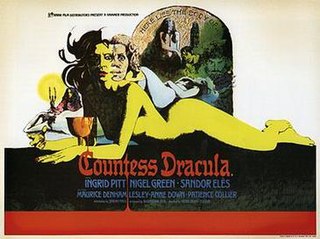
Countess Dracula is a 1971 British Hammer horror film directed by Peter Sasdy and starring Ingrid Pitt, Nigel Green and Lesley-Anne Down. It was produced by Alexander Paal.
Yutte Stensgaard is a Danish actress born in Thisted, Jutland, Denmark, best known for her starring role in Hammer's Lust for a Vampire (1971).

LGBT themes in horror fiction refers to sexuality in horror fiction that can often focus on LGBTQ+ characters and themes within various forms of media. It may deal with characters who are coded as or who are openly LGBTQ+, or it may deal with themes or plots that are specific to gender and sexual minorities.

Lust for a Vampire, also known as Love for a Vampire or To Love a Vampire, is a 1971 British Hammer Horror film directed by Jimmy Sangster, starring Ralph Bates, Barbara Jefford, Suzanna Leigh, Michael Johnson, and Yutte Stensgaard. It was given an R rating in the United States for some violence, gore, strong adult content and nudity. It is the second film in the Karnstein Trilogy, loosely based on the 1872 Sheridan Le Fanu novella Carmilla. It was preceded by The Vampire Lovers (1970) and followed by Twins of Evil (1971). The three films do not form a chronological development, but use the Karnstein family as the source of the vampiric threat and were somewhat daring for the time in explicitly depicting lesbian themes.
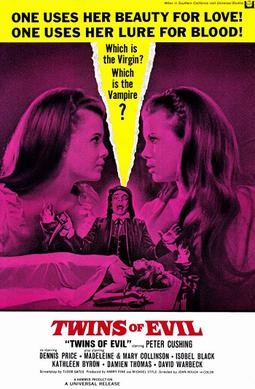
Twins of Evil is a 1971 British horror film directed by John Hough and starring Peter Cushing, with Damien Thomas and the real-life identical twins and former Playboy Playmates Mary and Madeleine Collinson.
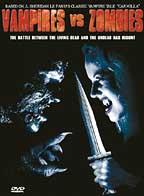
Vampires vs. Zombies is a 2004 American independent horror film loosely based upon J. Sheridan Le Fanu's classic 1872 novel Carmilla. Unlike Le Fanu's story, however, most of the action in the film takes place inside a car. The title and cover artwork were obviously inspired by the then-current horror film Freddy vs. Jason, but the movie itself bears less resemblance to this counterpart compared to other, more blatant Asylum mockbusters. The movie was originally titled Vampires vs. Zombies, but it has since then been changed to Carmilla, the Lesbian Vampire. Vince D'Amato is the director and screenwriter of this film.
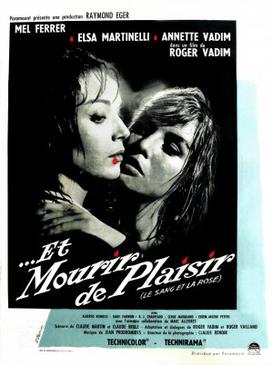
Blood and Roses is a 1960 erotic horror film directed by Roger Vadim. It is based on the novella Carmilla (1872) by Irish writer Sheridan Le Fanu, shifting the book's setting in 19th-century Styria to the film's 20th-century Italy.
The influence of Countess Elizabeth Báthory in popular culture has been notable from the 18th century to the present day. Since her death, various myths and legends surrounding her story have preserved her as a prominent figure in folklore, literature, music, film, games and toys.

"Dracula's Guest" is a short story by Bram Stoker, first published in the short story collection Dracula's Guest and Other Weird Stories (1914). It is believed to have been intended as the first chapter for Stoker's 1897 novel Dracula, but was deleted prior to publication as the original publishers felt it was superfluous to the story.
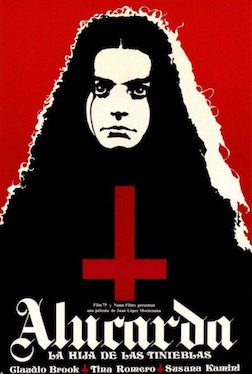
Alucarda is a 1977 English-language Mexican supernatural horror film directed by Juan López Moctezuma, and starring Tina Romero, Claudio Brook, Susana Kamini, and David Silva. A loose adaptation of Carmilla (1872), it revolves around two teenage orphan girls living in a Catholic convent, who unleash a demonic force and become possessed.
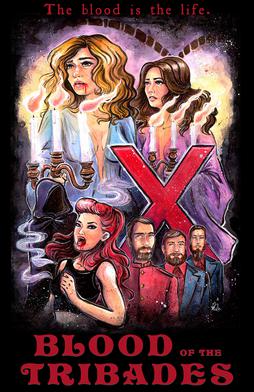
Blood of the Tribades is a 2016 horror film directed by Sophia Cacciola and Michael J. Epstein. The script, style, and look are heavily influenced by 1970s Euro lesbian vampire films. The film is distributed in North America on VOD and DVD/Blu-ray by Launch Over and VHS by SRS Media.

The Blood of the Vampire is a Gothic novel by Florence Marryat, published in 1897. The protagonist, Harriet Brandt, is a mixed-race psychic vampire who kills unintentionally. The novel follows Harriet after she leaves a Jamaican convent for Europe, and her ill-fated attempts to integrate with Victorian society.

















